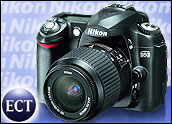
If you’ve ever owned an SLR camera, you can probably remember the first time you held it in your hands. I do.
Here, I thought, many years ago when I picked up my Minolta X7, is something of substance. Weighty, certainly, but also beautifully balanced — an inanimate object capable of animating its beholder.
That feeling was rekindled recently when I picked up Nikon’s latest digital SLR, the D50.
Deceptively Light
The camera actually appears heavier than it is. At 19 ounces it’s no feather, but I didn’t find its bulk too taxing even during shooting sessions lasting several hours.
To a point-and-shoot punter, the D50 may look a bit imposing, but closer inspection will reveal that its controls are similar to those found on a typical P-and-S camera.
On top of the unit, there’s an on-off dial with the shutter release at its center. The dial is flanked by buttons for setting the self-timer and performing manual adjustments for exposure compensation, aperture and flash compensation.
Behind the dial is a monochrome status LCD. That display will show you the camera’s mode status, battery life, memory available on its SD card and other shooting information.
Sophisticated Presets
To the left of the LCD is a typical mode dial. With it, you can choose your manual settings — programmed auto, shutter and aperture priority, and manual. And you can choose your presets — settings optimized for situations like landscapes, sports, night portraits, close ups and — one of my favorites — child shots.
While presets can be found in many digital cameras, Nikon has added a degree of sophistication to the scene modes in the D50. Not only do the modes set the camera’s mechanical aspects — aperture and shutter — for a scene, but they set its digital aspects, too.
For example, in portrait mode, the camera will not only choose a large aperture so the background of the subject will be out of focus, but it will tweak the shot to optimize flesh tones and use edge sharpening to enhance the photo without emphasizing every crevice and wrinkle in a face.
Viewfinder-Only Shooting
On the back of the camera, there’s a color LCD, which measures two-inches diagonally. If you’re a digital camera buff who’s used to framing shots in an LCD, it may take awhile to adjust to the D50. Framing and shooting images is done strictly through its optical viewfinder, which displays about 95 percent of a shot. For folks with less than perfect eyesight, the viewfinder has a diopter.
After you shoot a picture, it appears on the LCD so you can quickly decide if you want to keep it or not, or you can display it later and reevaluate it.
To the right of the LCD there’s a rocker dial for navigating through menus and a trash button for quickly deleting photos.
To the left of the LCD are controls for paging through photos on the memory card, displaying menus and thumbnails, controlling the white balance of a shot and changing the size and quality of an image.
Outstanding Photos
Photos taken with the D50 were outstanding and were comparable to those taken with a film SLR. The images were sharp and their color fidelity exceptional — even shots taken indoors with the unit’s pop-up flash. (The camera also has a “hot shoe” to accommodate an add-on flash.)
Best of all, there’s absolutely no shutter-lag with this camera. You press the shutter button and the response is immediate.
Connecting the unit to a computer was effortless. Windows XP recognized the camera immediately and uploaded its contents to my hard drive without a hitch.
Pricey but Worth It
As SLR veterans know, you don’t enter this niche unless you’re prepared to part with a significant amount of cash. Although digital SLR prices have declined significantly over the years — the first ones sold for US$5000 in 1999 — the latest models sell for more than $700. The Internet price range for the D50 is $699 to $749.
That’s just for the body. Be prepared to pay an additional $290 to $400 a piece for lenses. However, if you’re already a Nikon-o-phile, the company says the D50 will accept any of its lenses made since 1959–although all the features in some of those lenses may not work on the digital SLR.
But wait — there’s more. You’re going to need an optional SD card to store your pictures on the camera. That will set you back another $100 or so, if you go first class and buy a high speed — 60x — card with one gigabyte of memory.
It’s hard to beat the convenience and diminutive form of a point-and-shoot camera for catching most of life’s moments, but for that trip to Paris or the Grand Canyon, you may want more than you can get from a traditional point-and-shoot. An SLR like the Nikon D50 will give it to you.
John Mello is a freelance business and technology writer who can be reached at [email protected].





















































